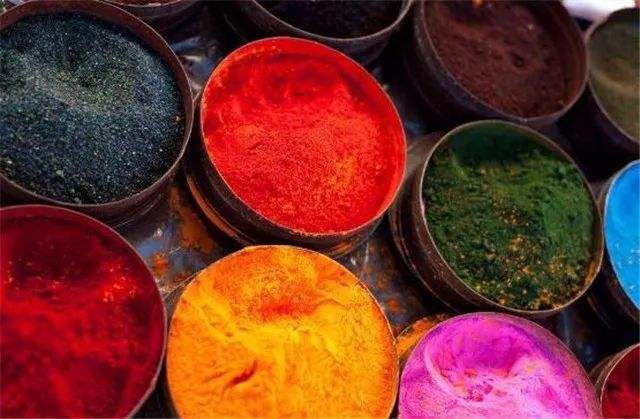Basic Dye molecules contain amino, substituted amino or nitrogen-containing heterocyclic compounds. These amines are in the form of organic alkali salts (such as hydrochloride, organic acid salt or zinc chloride double salt, etc.), which are called basic dyes. Early also known as base dyes. In 1856, h.w.perkin synthesized the world's first synthetic dye, aniline violet, which is an alkaline dye. After that, there were many varieties of basic fuchsin (C.I. basic violet 14), basic blue BO(C.I. basic blue 9), crystal violet (C.I. basic violet 3), malachite green (C.I. basic green 4) and rhodamine B(C.I. basic violet 10). The chemical structures of basic dyes are diarylmethane, triarylmethane, azo type and nitrogen-containing heterocyclic compounds (such as oxaanthracene, oxazine and thiazine). Basic dyes can be ionized into colored cations when dissolved in water, and can be applied to protein fibers such as wool and silk. It can also be used for dyeing acetate and acrylic fibers. Crystal violet, rhodamine and oxazine dyes can also be used as heat sensitive dyes, pressure-sensitive dyes and dye lasers.
As basic dye, it must have two conditions: one is to have color; the other is to have affinity with the dyed tissue. The color of dye and its affinity with tissue are determined by the molecular structure of dye itself. The chromophore that produces color and the chromophore that produces affinity with tissue together determine the dyeing properties of dye. Some groups of molecular structure absorb light of a certain wavelength instead of light of another wavelength, which makes people feel as if the substance "emits color", so these groups are called "chromophores".
For example, a derivative of benzene has a visible light absorption band and can be used as a chromogenic group. In addition, the chromogenic groups include nitro group (NO2), azo group (n = n, 1), vinyl group, etc. As a dye substance, in addition to the chromophore group, it also needs a chromophore group which can ionize the compound. It is composed of acid groups such as 0h-so3h and COOH, and basic groups such as NH2, nhch3 and n (CH3) 2. The existence of them can make the dye substance ionize, enhance the polarity, promote the interaction between dye and tissue, and produce dyeing effect. The dyes with acid groups in the color aid group are called acid dyes, while the dyes with basic groups in the color aid group are called basic dyes.
There are three basic dyes involved in high school: gentian violet(basic violet 3), magenta acetate and hematoxylin. This paper takes gentian violet as an example to explain the origin of the term "basic dye". The structural formula of gentian violet is shown in the figure, in which triphenylmethane forms the chromogenic group and (n (CH3) 2) forms the chromogenic group. (1) n (CH3) 2 is a polar group. When ionized in water, it can combine with H and be positively charged, so that the dye molecules can combine with the negatively charged substances, so that they can dye colors. In the preparation of gentian violet dye solution, acetic acid is usually added. Under acidic condition, h is more, which can promote the ionization polarization of gentian violet.
Alkaline dyes have affinity for wool, silk, leather and cotton fibers treated with tannin mordant, with strong coloring power and brilliant color. However, alkaline dyes have poor fastness to washing and sunlight. They are rarely used in dyeing of cotton, wool and other fiber fabrics. Most of them are used in coloring of paper (including carbon paper), typing ribbon, Lake photography, biology and other materials. Although the sensitivity of the method is high, the selectivity of the method is poor and there is mutual interference between the precious metals, so the separation and masking process before the determination is very important, and the operation process should be particularly detailed, which is also the focus of future research work. At the same time, it is suggested to adopt modern photometry, instruments and Metrology statistics to overcome the spectral interference among elements and innovate the methods. Finally, in order to give full play to the advantages of noble metal catalytic spectrophotometry with alkaline dyes, more applied studies should be carried out to explore the best application conditions of different alkaline systems and achieve more accurate determination.
The definition of basic (or acid) dyestuffs is not determined by the pH value of the dye solution, but by the charge of the chromophore ionized in the dye substance. Generally speaking, the dye with positive charge of auxiliary color group is alkaline dye, otherwise it is acid dye. Take two kinds of basic dyes, acetic acid magenta and gentian violet, which are commonly used in high school students' experiments as examples to see the pH value of basic dyes.. First of all, from the perspective of preparation method. Preparation process of gentian violet dye solution: dissolve gentian violet in 2% acetic acid solution until the solution does not turn dark purple; preparation process of acetic acid magenta: take 100mla5% acetic acid, boil for 30s, add 1g magenta, stir, and boil for 2 ~ the solvent used in the preparation process of these two basic dyes is acetic acid.
The chromatin (body) in the nucleus contains deoxyribonucleic acid (DNA), which is an acid substance. It can ionize h and make itself negatively charged. Therefore, it can firmly combine with the positively charged auxiliary color group ionized by basic dyes (such as gentian violet) through the gravitational action between the charges, so that it can be dyed by the dyes. In the experiment of "observation of mitosis of plant cells", if hydrochloric acid is used for dissociation and direct staining without rinsing, then as hydrochloric acid is a strong acid and deoxyribonucleic acid is a weak acid, the presence of hydrochloric acid will inhibit the ionization of deoxyribonucleic acid, so that deoxyribonucleic acid can not be combined with the positively charged color aid group in gentian violet, so that the chromatin can not be dyed

